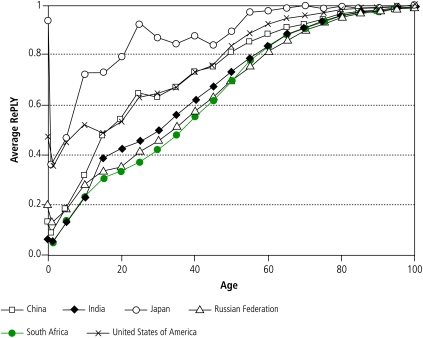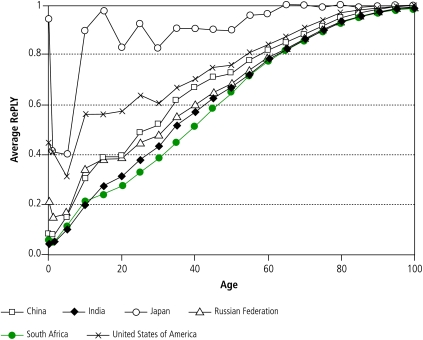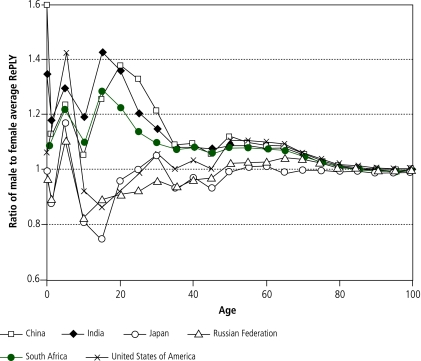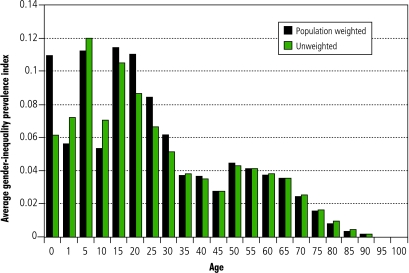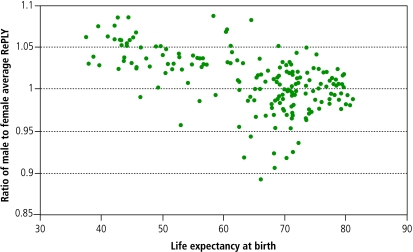Abstract
Objective
We propose a new method to measure health inequalities caused by conditions amenable to policy intervention and use this to identify health differences between sexes and age groups.
Methods
The lowest observed mortality rates are used as a proxy of unavoidable mortality risks to develop a new measure of health outcome – realization of potential life years (RePLY). The RePLY distribution is used to measure avoidable health inequalities between sex and age groups respectively.
Findings
Using RePLY we find that even those countries with very high life expectancy at birth can have substantial health inequalities across different age groups. Also, gender inequality is more pronounced among those aged < 30. Among countries with a life expectancy < 60 years, there is a much larger prevalence of gender inequality against females; countries with life expectancy > 60 years have comparable numbers of cases of inequality among females and males. Finally, high avoidable health inequality is associated with low average income, high income inequality and high population fractionalization.
Conclusion
It is important to distinguish between unavoidable and avoidable mortality when measuring health outcomes and their distribution in society. The proposed new measure (RePLY) enables policy-makers to focus on age-sex groups with low realization of potential life years and thus high avoidable mortality risks.
Résumé
Objectif
Nous proposons une nouvelle méthode pour mesurer les inégalités en termes de santé pouvant être réduites par des interventions et nous l’utilisons pour identifier les différences en termes de santé entre les sexes et les tranches d’âges.
Méthodes
Les taux de mortalité les plus bas observés ont été utilisés comme approximation des risques mortels inévitables afin de mettre au point un nouveau paramètre de mesure des résultats dans le domaine sanitaire : les années de vie potentielles vécues (RePLY). La distribution des RePLY est utilisée pour mesurer les inégalités en matière de santé évitables entre les sexes et les classes d’âges.
Résultats
A l’aide de cette mesure, nous constatons que les pays bénéficiant d’une très longue espérance de vie à la naissance peuvent présenter des inégalités substantielles en matière de santé entre les classes d’âges. De même, les inégalités liées au sexe sont plus prononcées chez les moins de 30 ans. Dans les pays où l’espérance de vie est inférieure à 60 ans, on relève une prévalence bien plus marquée des inégalités liées au sexe en défaveur des femmes ; dans les pays où l’espérance de vie dépasse 60 ans, les nombres de cas d’inégalités entre hommes et femmes sont comparables. Enfin, d’importantes inégalités évitables en matière de santé sont associées à de faibles revenus moyens, à de fortes inégalités en matière de revenus et à un fort fractionnement de la population.
Conclusion
Il importe de faire la distinction entre mortalité évitable et inévitable lorsqu’on mesure des paramètres sanitaires et leur distribution dans la société. La nouvelle mesure proposée (RePLY) permet aux décideurs de cibler leur action sur les groupes, constitués en fonction de l’âge ou du sexe, qui ne réalisent qu’une faible partie de leur potentiel de vie et ainsi sur les risques mortels évitables.
Resumen
Objetivo
Proponemos un nuevo método para medir las desigualdades sanitarias causadas por trastornos que puedan modificarse con intervenciones de políticas y lo hemos utilizado para identificar diferencias sanitarias entre los sexos y entre diferentes grupos de edad.
Métodos
Utilizando las menores tasas de mortalidad observadas como indicador indirecto del riesgo de mortalidad inevitable, hemos creado una nueva medida de los resultados sanitarios, denominada realización de los años de vida potenciales (RAVP), cuya distribución utilizamos para medir las desigualdades sanitarias evitables entre los sexos y entre diferentes grupos de edad.
Resultados
Utilizando la RAVP, verificamos que incluso los países con una esperanza de vida muy elevada al nacer pueden presentar desigualdades sanitarias considerables entre diferentes grupos de edad. Las desigualdades entre sexos son más marcadas entre los menores de 30 años. En los países con una esperanza de vida < 60 años hay una prevalencia mucho mayor de desigualdades entre sexos desfavorables a las mujeres; los países con esperanza de vida > 60 años tienen cifras similares de desigualdades desfavorables a los hombres y a las mujeres. Las grandes desigualdades sanitarias evitables se asociaron a bajos ingresos medios, grandes desigualdades de ingresos y gran fraccionamiento de la población.
Conclusión
A la hora de medir los resultados sanitarios y su distribución en la sociedad es importante distinguir entre mortalidad evitable e inevitable. La nueva medida propuesta permite a los planificadores de políticas centrarse en los sexos y los grupos de edad con baja RAVP y, por consiguiente, alto riesgo de mortalidad evitable.
ملخص
الغرض
نطرح في ەذە الورقة طريقة جديدة لقياس مظاەر الجور والتفاوت في المجال الصحي، الناجمة عن أوضاع يمكن التغلُّب عليەا من خلال السياسات، وكيفية الاستفادة من ەذە الطريقة في تحديد الفروق الصحية بين الجنسين وبين الفئات العمرية.
الطريقة
استُخدمت أدنى معدلات الوفيات الملاحظة، بوصفەا مؤشراً بديلاً لمخاطر الوفاة التي لا يمكن تجنبەا، لوضع مقياس جديد للحصيلة الصحية – وەو سنوات العمر الممكنة. واستُخدم توزُّع سنوات العمر الممكنة لقياس مظاەر الجور والتفاوت في المجال الصحي بين الجنسين وبين الفئات العمرية.
الموجودات
توصلنا من خلال تطبيق مقياس سنوات العمر الممكنة إلى أنە حتى البلدان التي تتمتَّع بمأمول حياة بالغ الارتفاع عند الولادة، قد تعاني من مظاەر واضحة للجور والتفاوت في مختلف الفئات العمرية. كما لوحظ أن مظاەر الجور والتفاوت أكثر وضوحاً بين من ەم أقل من عمر 30 عاماً. وفي البلدان التي يقل مأمول الحياة فيەا عن 60 عاماً، تنتشر مظاەر الجور والتفاوت انتشارا عريضا ضد الإناث؛ أما في البلدان التي يزيد مأمول الحياة فيەا على 60 عاماً، فيُلاحظ تقارب عدد حالات الجور والتفاوت بين الإناث والذكور. ولوحظ كذلك أن مظاەر الجور والتفاوت، التي يمكن تجنُّبەا إلى حد بعيد، ترتبط بانخفاض مستوى الدخل وزيادة التفاوت في مستويات الدخل وشدَّة تفتُّت السكان.
الاستنتاج
من المەم التفريق بين الوفيات التي يمكن تجنبەا وبين تلك التي لا يمكن تجنُّبەا، وذلك عند قياس الحصائل الصحية وتوزُّعەا في المجتمع. ويتيح المقياس الجديد الـمُقتَـرَح (سنوات العمر الممكنة) لراسمي السياسات التـركيز على فئات العمر والجنس المنخفضة في مقياس سنوات العمر الممكنة، ومن ثم تكون أشد عرضة لمخاطر الوفاة التي يمكن تجنُّبەا.
Introduction
Although the past 50 years have seen substantial improvements in the average level of health as measured by mortality rates in many countries, health inequalities have remained static or widened.1 Against this background, in 2000 WHO declared the reduction of health inequalities between and within countries to be a priority. It aims to use health inequality – in addition to the average level of health, average level and distribution of responsiveness and fairness in financial contributions – as a distinct parameter to assess the performance of national health systems.2 This paper contributes to health-inequality methodology by proposing a new measure for isolating health outcomes that are amenable to intervention.
Measurement of health inequality requires a health outcome or health status that is unidimensional and measurable on a cardinal scale, much like income.3 Several variables satisfy these requirements (including height, body weight and child mortality) but we focus on age at death. Healthier persons are expected to live longer and age-at-death distribution is a frequently used measure of health inequality.4–7 However, not all fatal health outcomes have the same welfare implications, as demonstrated in the following example.
Person A died from a genetic disorder aged 40. If current technology cannot provide a cure for this disease, more health-related resources could not have extended A’s lifespan beyond 40. From a policy perspective, sufficient resources were expended to fully realize A’s potential life years. B died of malaria aged 60, although with access to more health-related resources B would have been expected to live until, say, 80. From a policy perspective, B received resources that allowed the realization of only 75% of potential life years. Health inequality measured by age-at-death would have concluded that A should have received more, and B fewer, resources. That would have wasted resources and lowered the overall welfare of society.
Considering this limitation, we propose to define health equality as the state where everyone in the population can realize his/her own potential life years to the same degree. According to this definition, not everyone in a society that has achieved health equality will necessarily have an identical age at death. We propose a new measure to implement this concept – realization of potential life years (RePLY). RePLY is defined as the ratio of age at death to the potential length of life, and would replace age-at-death as an indicator of health outcome. In the given example, A and B will have RePLYs equal to 1.0 and 0.75 respectively. RePLY distribution can be used to measure health inequalities that have the potential to be reduced by reallocating resources within the population. Thus, the proposed measures are in line with WHO’s call for health systems to focus on the best attainable average level and on inequalities caused by conditions amenable to intervention.2
Unlike commonly used health indexes (life expectancy; child mortality rate), RePLY can measure commensurable differences between age and sex groups that are responsive to policy intervention but not evidenced easily due to the natural differences in their mortality risks. Age-related health inequalities might not be particularly prominent on policy agendas, but implicit judgments on age-related inequality are made in almost all health policy decisions. For instance, often it is suggested that measures of the burden of disease should be age-weighted. Williams has proposed the “fair innings” argument for taking account of age-inequalities when evaluating the cost-effectiveness of different interventions.8,9 Gender-related inequality tends to be age-dependent. This prominent policy issue will be discussed further.
Methods
There are three steps for using RePLY to measure health inequalities: (1) separating avoidable and unavoidable deaths for each age-sex group in a population; (2) computing the value of RePLY for each type of death for each age-sex group; (3) constructing health-inequality measures using the computed RePLY.
Avoidable and unavoidable deaths
Generally, mortality risks can be reduced by improving resource availability. However, some cannot be eliminated completely with current technology and resources. Risks such as those related to chance and genes are considered to be unavoidable (or natural) mortality risks. These are expected to vary with age, sex and time due to technological progress and environmental changes.
A reference country is a hypothetical country that has the lowest conditional probability of dying for each age-sex group among all countries. It is considered practically as free from avoidable mortality risks for a given state of technology and the resources available to society at the time of measurement. The reference country’s mortality profile is the benchmark that defines unavoidable mortality risks. This approach, proposed by William Farr in the late nineteenth century, has been applied in several health-inequality studies.10–13
The conditional probability of dying for a person aged x in the reference country ( ) can be defined as:
) can be defined as:
 |
K = number of countries. = conditional probability that a person in country k who survives to age x will die before reaching the next birthday.The reference country mortality profile was constructed using the 191 countries in WHO’s life tables for 2000.14 Some have incomplete vital statistics, therefore any inequality measures derived for these countries should be used with caution. However, the derived RePLY-based measures still reflect the avoidable health inequalities implied by the models used to construct the data. Moreover, results from sensitivity analyses show that the reference distribution of unavoidable mortality risks is very robust to this limitation. Details of the construction process, results and sensitivity tests can be found in two related studies.15,16
= conditional probability that a person in country k who survives to age x will die before reaching the next birthday.The reference country mortality profile was constructed using the 191 countries in WHO’s life tables for 2000.14 Some have incomplete vital statistics, therefore any inequality measures derived for these countries should be used with caution. However, the derived RePLY-based measures still reflect the avoidable health inequalities implied by the models used to construct the data. Moreover, results from sensitivity analyses show that the reference distribution of unavoidable mortality risks is very robust to this limitation. Details of the construction process, results and sensitivity tests can be found in two related studies.15,16
Fig. 1 shows the reference country mortality profile, constructed separately for females and males to allow for differences in their natural mortality risks. If another country’s conditional probability of dying by age (e.g. Cambodia) is plotted on the same graph, its curves will lie above, or at best on, the reference curves. The reference curves constitute a “frontier” (when viewed from below) for mortality risks. The distance from the x-axis to the frontier is a measure of the unavoidable mortality risks; the distance from the probability curve to the frontier is a measure of avoidable mortality risks.
Fig. 1.
Conditional probability of dying by age and gender of the reference country and Cambodia
The number of unavoidable deaths in a given age-sex group is not directly observable but can be estimated by multiplying the group’s population with its conditional probability of dying from unavoidable causes. By definition, the latter is equal to the conditional probability of dying in the reference country for the same age-sex group. Once the number of unavoidable deaths is computed, the number of avoidable deaths can be obtained. Avoidable and unavoidable deaths are separated by the probability of death in each group rather than the actual causes of deaths. Thus, avoidable deaths in this paper include those that can be reduced by both medical and non-medical interventions (such as gun controls).
The incidence of global avoidable mortality will change as technology improves. It may go up or down, depending on whether the countries that define the frontier are getting farther ahead or whether the countries below it are catching up. Technological progress will shift the frontier distribution of unavoidable mortality risks down and away from other countries’ distributions, increasing their avoidable mortality. It will also lower the cost of existing technologies, facilitating the development of health systems in poorer countries. Applied to Fig. 1, this effect could shift Cambodia’s probability curves downward, reducing its avoidable mortality. Thus RePLY can be used to analyse the dynamics of avoidable health inequalities when applied to panel data.
Computing for each type of death
Those who die from unavoidable causes have, by definition, fully realized the potential lifespan that nature allows and have a RePLY equal to one. Conversely, those who die from avoidable causes realize only a fraction: with as many health-related resources as their peers in the reference country, they would have had the same expected lifespan. Therefore, the RePLY for an avoidable death at age x is equal to x divided by  , where
, where  is the life expectancy for a person aged x in the reference country. Inequalities in RePLY indicate that the overall health outcome of the population can be improved by reallocating resources between subgroups.
is the life expectancy for a person aged x in the reference country. Inequalities in RePLY indicate that the overall health outcome of the population can be improved by reallocating resources between subgroups.
An alternative approach takes the maximum observed life expectancy among the 191 countries as the absolute standard of health status attainment. The shortfall between an observed life expectancy and this absolute standard is a measure of health outcome.8,17,18 Although this method bears some similarity to RePLY, it assumes that all deaths are avoidable, including those in the best-performing, standard-setting countries.
Mortality and morbidity are closely related and can interact in several different ways.19 Yet the state of mortality inequalities does not necessarily reflect that of morbidity. As more robust data become available on morbidity, it is desirable to extend RePLY to measure the avoidable loss of quality-adjusted life years (QALYs).
Constructing health-inequality measures
There is debate on whether health inequalities should be measured across individuals or population subgroups.20–24 Ideally, we would like to measure both within- and between-group inequalities, and use other methods like regression or correlation to examine the factors affecting total and partial inequalities.25 However, the stratification of the WHO life tables limits our scope to age- and sex-related inequalities.
This paper focuses on intercountry inequalities and is more useful for international health monitoring and policy-making. The method could be applied to construct a reference distribution across different regions within a country. This enables a focus on intracountry inequalities and thus is more helpful for determining health policy at local levels.
Findings
Scatter plots of both male and female RePLYs against age for selected countries are given (Fig. 2, Fig. 3). Japan’s RePLY for neonates is close to one, indicating a very small proportion of avoidable infant mortality. Nonetheless, Japanese male RePLY drops dramatically from age one, and does not return to the neonate-level until age 60. In the 1–5 age group those who die have realized, on average, less than 40% of their potential life years. Japanese females also suffer a big drop in RePLY from age one, but recover to 0.9 level by the age of ten. The policy implication is that the Japanese health system may need to direct more attention, and possibly more resources, to children aged < 10.
Fig. 2.
Average RePLY by age at death – males
Fig. 3.
Average RePLY by age at death – females
We give a scatter plot of the ratio of male RePLY to female RePLY against age (Fig. 4). A ratio greater (smaller) than one indicates gender inequality against females (males). China has the highest gender inequality for infants – an astonishing 1.6 (i.e. RePLY is 60% higher for baby boys). This is likely to be related to the one-child policy and the social preference for boys.26 Conversely, in Japan and the Russian Federation, males are worse off for many subgroups aged < 50. This is probably related to high suicide rates among young Japanese males and the impacts of alcohol abuse and violence on Russian males.27,28
Fig. 4.
Ratio of male to female average RePLY by age at death
A gender inequality prevalence index can be calculated using the male and female average RePLYs for each age group for each country:
The index is bounded between zero and one; a higher value indicates a greater prevalence of inequality against either females or males. We then compute the population-weighted and unweighted average of the index values across 191 countries. As shown in Fig. 5, gender inequality is most prevalent for those aged < 30. This age group has substantially different weighted and unweighted index averages too, indicating that the degree of gender inequality varies substantially across countries.
Fig. 5.
Average gender inequality prevalence index against age
National-level gender inequality is contrasted with life expectancy at birth (Fig. 6). Most countries with relatively low life expectancy at birth also have higher female inequality. Countries with relatively high life expectancy at birth show equally prevalent inequalities against males and females. The highest female inequalities are found mostly in low-income south Asian or African countries, such as Nepal (1.087) and Botswana (1.085); the highest male inequalities are found mostly among independent states of the former Soviet Union, including the Russian Federation (0.893) and Kazakhstan (0.918).
Fig. 6.
Ratio of male to female average RePLY against life expectancy at birth across countries
The prevalence of female inequality in developing countries may occur because the survival of males is considered to be more important in poor economic conditions.29,30 Also, when females (especially mothers) are in poor health, the health of their family members (particularly children) may also suffer,31 leading to low life expectancy for the whole population.
Lastly, we investigate how the health-inequality measures based on RePLY relate to inequality measures based on other parameters. Table 1 (available at: http://www.who.int/bulletin/volumes/85/9/06-037382/en/index.html) shows the correlation coefficients between the RePLY Gini coefficient and the gender inequality prevalence index; and between GDP per capita, income Gini coefficient and three population fractionalization indexes.32 All indexes are measured at the national level, and a larger fractionalization index value means the population is more heterogeneous along that dimension. As expected, avoidable health inequality is correlated negatively to average income level but positively to income inequality. Avoidable health inequality correlates positively to three measures of population fractionalization, although the correlation with the religion fractionalization index is much smaller. Ethnicity and language are associated with health status because they are considered to reflect the effects of culture, class, life-course changes, discrimination, geographical self-clustering and isolation from the mainstream.33
Table 1. Correlation between RePLY-based inequality measures and socioeconomic factors.
| RePLY Gini coefficient | Gender inequity prevalence index | |
|---|---|---|
| GDP per capita | –0.65 | –0.34 |
| Income Gini coefficient | 0.55 | 0.17 |
| Ethnicity fractionalization | 0.57 | 0.22 |
| Language fractionalization | 0.54 | 0.27 |
| Religion fractionalization | 0.14 | 0.11 |
Sources: Income Gini coefficient data are drawn from the UNU/WIDER World Income Inequality Database, version 2.0 beta (available at: www.wider.unu.edu/wiid/WIID2beta.pdf) based on disposable income wherever possible, otherwise net income. Only countries that WIDER classifies as having reliable data are selected. Income inequality indices for 2000 are used when available; otherwise indices for the next closest year are used, allowing a maximum difference of 5 years. Only 77 countries are included in this calculation due to non-availability of income inequality data – 29 of the 77 are OECD countries. GDP per capita data are drawn from the World Development Indicators 2005 (Washington: World Bank; 2005). The figures are expressed in terms of PPP (constant 2000 international dollars); 159 countries are included. Ethnicity, language and religion fractionalization indexes are drawn from a study by Alesina et al. (Alesina A, Devleeschauwer A, Easterly W, Kurlat S, Wacziarg R. Fractionalization. Journal of Economic Growth 2003: 8:155-94). Ethnicity data are from various years, covering 185 countries. Language and religion data are from 2001, covering 178 and 187 countries respectively.
Gender-related health inequality, as measured by the prevalence index, is found to have a much smaller correlation with the five socioeconomic indicators, yet the signs match those of the RePLY Gini coefficient. A possible explanation is that most gender inequality takes place within, rather than between, different income or ethnolinguistic groups.
Conclusion
Using the mortality rate frontier among a large number of countries as a benchmark of unavoidable mortality risks, we construct a measure of individual health outcome – RePLY. This can illustrate the health inequalities caused by conditions that are amenable to intervention, thereby helping policy-makers to identify the most cost-effective interventions to reduce inequalities and improve health. The proposed measure echoes the notion of effective coverage suggested recently by Shengelia and colleagues.34
RePLY’s usefulness is demonstrated by examining age- and gender-related health inequalities among 191 countries. RePLY-based measures are more informative than conventional measures (such as life expectancy) as they expose inequalities that are concealed by differences in natural mortality risks between age and gender groups. RePLY can be applied readily to measure inequalities along other socioeconomic dimensions, such as ethnicity or class, and extended to incorporate morbidity as well as mortality. Since the inequalities measured can be alleviated by reallocating resources between groups within a population, RePLY can reflect not only health inequality but also social disadvantage.35 ■
Footnotes
Competing interests: None declared.
References
- 1.Acheson D. Health inequalities impact assessment. Bull World Health Organ. 2000;78:75–6. [PMC free article] [PubMed] [Google Scholar]
- 2.The world health report 2000. Geneva: WHO; 2000.
- 3.Wolfson M, Rowe G. On measuring inequalities in health. Bull World Health Organ. 2001;79:553–60. [PMC free article] [PubMed] [Google Scholar]
- 4.Le Grand J. Inequality in health. Some international comparisons. Eur Econ Rev. 1987;31:182–91. doi: 10.1016/0014-2921(87)90030-4. [DOI] [Google Scholar]
- 5.Le Grand J. An international comparison of distributions of ages-at-death. In: Fox J, ed. Health inequalities in European countries. Aldershot: Gower; 1989, p. 75-91. [Google Scholar]
- 6.Silber J. ELL (the equivalent length of life) or another attempt at measuring development. World Dev. 1983;11:21–9. doi: 10.1016/0305-750X(83)90084-0. [DOI] [Google Scholar]
- 7.Hicks N, Steeten P. Indicators of development: the search for a basic needs yardstick. World Dev. 1979;7:567–80. doi: 10.1016/0305-750X(79)90093-7. [DOI] [Google Scholar]
- 8.Williams A. Intergenerational equity: an exploration of the ’fair innings’ argument. Health Econ. 1997;6:117–32. doi: 10.1002/(SICI)1099-1050(199703)6:2<117::AID-HEC256>3.0.CO;2-B. [DOI] [PubMed] [Google Scholar]
- 9.Murray CJL, Lopez AD. The global burden of disease: a comprehensive assessment of mortality and disability from diseases, injuries, and risk factors in 1990 and projected to 2020. Cambridge: Harvard University Press; 1996. [Google Scholar]
- 10.Farr W. Methods for comparing local with standard death-rates. In: Vital statistics, part IV - deaths. London: Office of the Sanitary Institute; 1885, p. 128-130. [Google Scholar]
- 11.Uemura K. Excess mortality ratio with reference to the lowest age-sex-specific death rates amongst countries. World Health Stat Q. 1989;42:26–41. [PubMed] [Google Scholar]
- 12.Woolsey TD. Toward an index of preventable mortality. In: Vital and health statistics: series 2, data evaluation and methods research. Hyattsville: Department of Health and Human Services; 1981. [PubMed] [Google Scholar]
- 13.McCracken K. What if New South Wales was more equal? N S W Public Health Bull. 2002;13:123–7. doi: 10.1071/NB02053. [DOI] [PubMed] [Google Scholar]
- 14.World mortality in 2000: life tables for 191 countries. Geneva: WHO; 2002.
- 15.Tang KK, Chin JTC, Rao DSP. Avoidable mortality risks and measurement of wellbeing and inequality (MRG working paper no.9). Brisbane: University of Queensland; 2006.
- 16.Tang KK, Petrie D, Rao DSP. Measuring health inequality with realization of potential life years. Paper presented at UNU-WIDER advancing health equity conference, Helsinki, 29-30 September 2006. [Google Scholar]
- 17.Ruger JP. Measuring disparities in health care. BMJ. 2006;333:274. doi: 10.1136/bmj.333.7562.274. [DOI] [PMC free article] [PubMed] [Google Scholar]
- 18.Ruger JP. Ethics and governance of global health inequalities. J Epidemiol Community Health. 2006;60:998–1002. doi: 10.1136/jech.2005.041947. [DOI] [PMC free article] [PubMed] [Google Scholar]
- 19.Murray CJL, Chen LC. Understanding morbidity change. Popul Dev Rev. 1992;18:481–503. doi: 10.2307/1973655. [DOI] [Google Scholar]
- 20.Gakidou EE, Murray CJL, Frenk J. Defining and measuring health inequality: an approach based on the distribution of health expectancy. Bull World Health Organ. 2000;78:42–54. [PMC free article] [PubMed] [Google Scholar]
- 21.Murray CJL. Commentary: comprehensive approaches are needed for full understanding. BMJ. 2001;323:680–1. [Google Scholar]
- 22.Murray CJL, Gakidou EE, Frenk J. Response to P Braveman et al. Bull World Health Organ. 2000;78:234–5. [Google Scholar]
- 23.Braveman P, Krieger N, Lynch J. Health inequalities and social inequalities in health. Bull World Health Organ. 2000;78:232–3. [PMC free article] [PubMed] [Google Scholar]
- 24.Braveman P, Starfield B, Geiger HJ. World health report 2000: how it removes equality from the agenda from public health monitoring and policy. BMJ. 2001;323:678–80. doi: 10.1136/bmj.323.7314.678. [DOI] [PMC free article] [PubMed] [Google Scholar]
- 25.Murray CJL, Gakidou EE, Frenk J. Health inequalities and social group differences: what should we measure? Bull World Health Organ. 1999;77:537–43. [PMC free article] [PubMed] [Google Scholar]
- 26.Yu M-Y, Sarri R. Women’s health status and gender inequality in China. Soc Sci Med. 1997;45:1885–98. doi: 10.1016/S0277-9536(97)00127-5. [DOI] [PubMed] [Google Scholar]
- 27.Fukuda Y, Nakamura K, Takano T. Municipal socioeconomic status and mortality in Japan: sex and age differences, and trends in 1973–1998. Soc Sci Med. 2004;59:2435–45. doi: 10.1016/j.socscimed.2004.04.012. [DOI] [PubMed] [Google Scholar]
- 28.Chen LC, Wittgenstein F, McKeon E. The upsurge of mortality in Russia: causes and policy implications. Popul Dev Rev. 1996;22:517–30. doi: 10.2307/2137719. [DOI] [Google Scholar]
- 29.Murthi M, Guio A-C, Dreze J. Mortality, fertility, and gender bias in India: a district-level analysis. Popul Dev Rev. 1995;21:745–82. doi: 10.2307/2137773. [DOI] [Google Scholar]
- 30.Vlassoff C. Gender inequalities in health in the third world: uncharted ground. Soc Sci Med. 1994;39:1249–59. doi: 10.1016/0277-9536(94)90357-3. [DOI] [PubMed] [Google Scholar]
- 31.Leslie J. Women’s nutrition: the key to improving family health in developing countries? Health Policy Plan. 1991;6:1–19. doi: 10.1093/heapol/6.1.1. [DOI] [Google Scholar]
- 32.Alesina A, Devleeschauwer A, Easterly W, Kurlat S, Wacziarg R. Fractionalization. J Econ Growth. 2003;8:155–94. doi: 10.1023/A:1024471506938. [DOI] [Google Scholar]
- 33.Nazroo JY. Genetic, cultural or socio-economic vulnerability? Explaining ethnic inequalities in health. Sociol Health Illn. 1998;20:710–30. doi: 10.1111/1467-9566.00126. [DOI] [Google Scholar]
- 34.Shengelia B, Tandon A, Adams OB, Murray CJL. Access, utilization, quality, and effective coverage: an integrated conceptual framework and measurement strategy. Soc Sci Med. 2005;61:97–109. doi: 10.1016/j.socscimed.2004.11.055. [DOI] [PubMed] [Google Scholar]
- 35.Tang KK, Rao DSP. Measuring social disadvantage with avoidable mortality risks. In: Tisdell C, ed. Poverty, poverty alleviation, and social disadvantage. New Delhi: Serials Publications; 2007. [Google Scholar]




